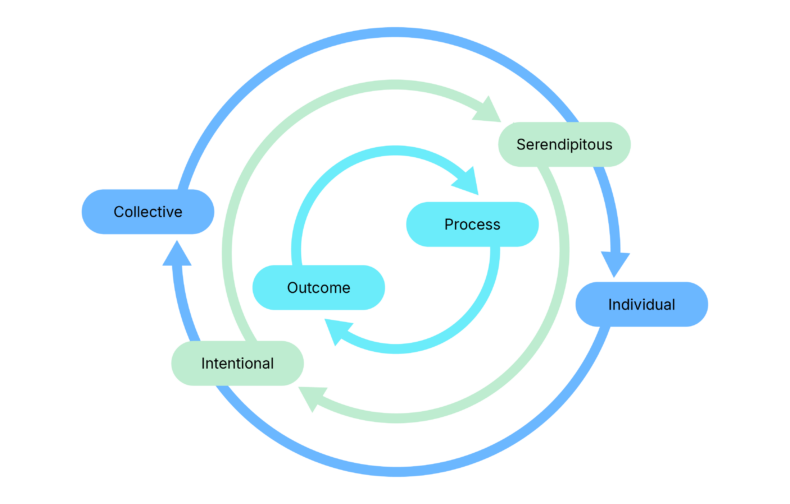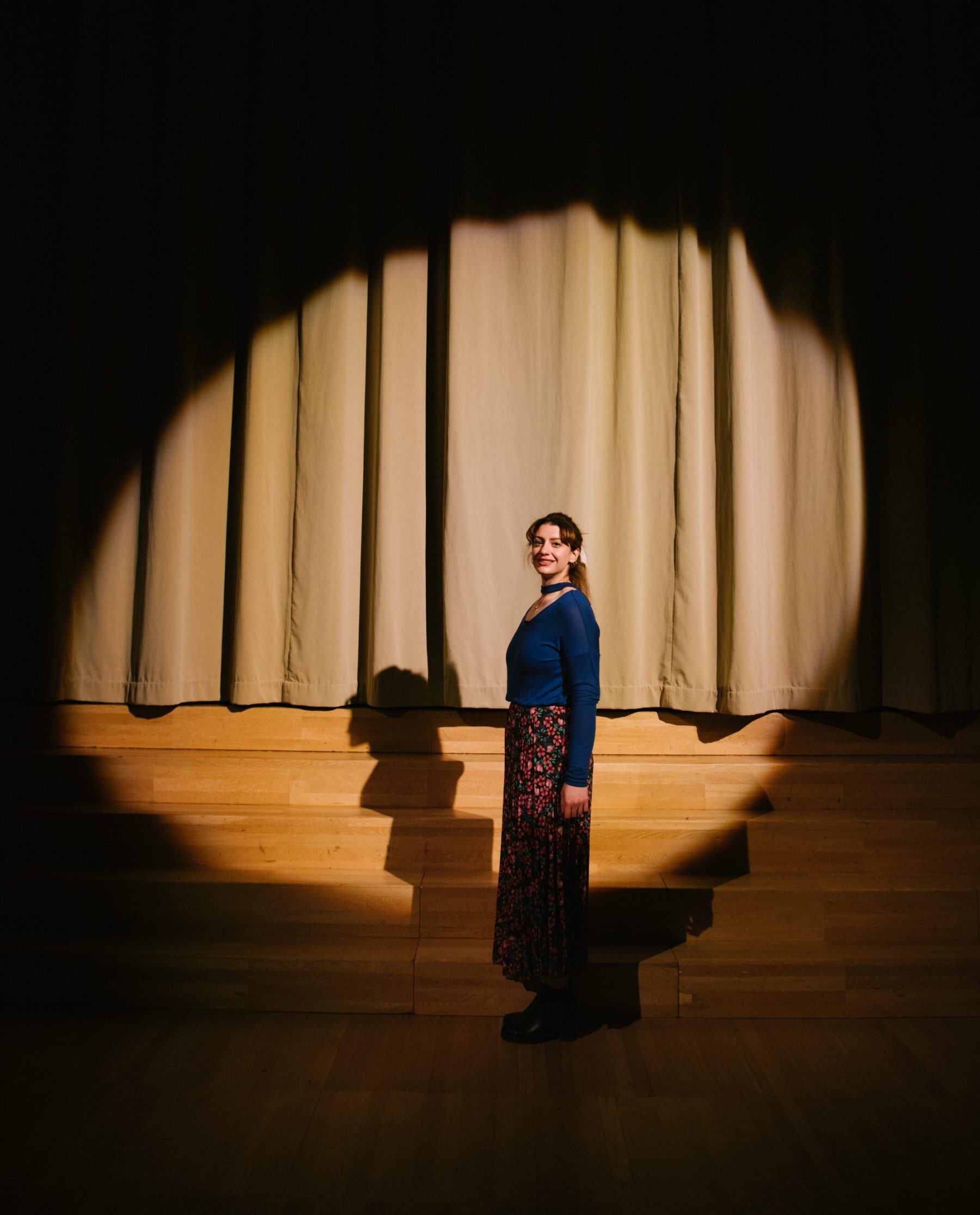Creativity inside and outside the box
How can we come up with creative solutions?
Researcher Margaret Boden2 categorized human creativity into three types: combinational (familiar ideas are recombined to come up with something new); exploratory (exploring a conceptual space); and transformational (transforming a conceptual space). A conceptual space is the rules, structures or assumptions underlying a given domain or a theme.
Boden’s three categories of creativity can be seen as a spectrum. Transforming a conceptual space makes it possible to come up with ideas or thoughts that were impossible within that framework. This form of creativity goes beyond merely exploring or recombining existing elements within a domain; it involves changing the domain itself in such a way that opens up entirely new possibilities for thought and innovation.
- Combinational creativity is the most immediate form of creativity, where existing ideas, concepts or elements are combined in novel ways to produce something new. This doesn’t require altering the fundamental rules of the domain but simply seeing new connections or relationships between known elements.
- Exploratory creativity involves a deeper engagement with the domain, where an individual or a group systematically explores the boundaries and possibilities within an existing framework of rules or concepts. It’s about pushing the limits of what’s known and discovering new insights or innovations that still fit within the established structures.
- Transformational creativity involves altering or expanding the existing conceptual space. By changing the rules, assumptions or fundamental structures of a domain, entirely new types of ideas and innovations become possible. Transformational creativity allows for a re-imagining of what is conceivable, enabling thoughts and creations that could not have existed within the original parameters.
This third type of creativity is the most radical3.
It’s possible to learn to be better at all of the three forms of creativity, though we can never totally control creativity. What we can do is create the mental and physical space for creativity to happen. We can tend the fertile soil in which we plant the seeds for radical creativity to grow.
Case study
Looking differently
Well done! You have successfully completed this assignment.
Radical creativity in real life
How can you be radically creative? What does striving for radical creativity look like?
To understand creativity better, it can help to examine the lives and experiences of people whose job is to be creative. What do they think of the term radical creativity? What does it mean to them on a practical level? A qualitative research project at Aalto University investigated this question1. Radical creativity is one of Aalto’s core values and is therefore often discussed within the community, making Aalto an ideal place to research what this idea means, as well as whether and how it gets realized.
The research project found that people conceptualize radical creativity through connected pairs of terms: process and outcome; individual and collective; serendipitous and intentional. These help frame the concept of radical creativity and bring it closer to practice. We will go over these six elements next, after the reflection.
Figure summary
The various aspects of radical creativity
Radical creativity can take place at any stage of doing something creatively:
- Not only the outcome can be radically creative, but also the process itself.
- Radical creativity can be intentionally sought for, but also a result of serendipity.
- Furthermore, not only an individual but also a collective can be radically creative.

Reflection
Well done! You have successfully completed this assignment.
The six elements of radical creativity
Process and outcome
A radically creative process is a novel approach for solving a problem or addressing a research question. In research, this might mean borrowing methodologies from different fields and applying them in a new context, which can happen through collaboration with researchers from a different field. In education, radical creativity as a process could involve focusing on creating room for exploration through different methods and activities.
Radically creative outcomes are evaluated in terms of whether they have a significant impact on society. A radically creative outcome is unexpected and might even seem impossible or unacceptable when first introduced. For instance, Galileo Galilei’s astronomical observation of Jupiter’s moons led to ideas that were radical at first but are now considered significant contributions to physics and astronomy.
In other words, process is about doing or making something in a new way, while outcome is about the idea or creation having a transformative effect on society.
Individual and collective
Radical creativity at an individual level involves the personal mindset and practices that create its foundation. For example, keeping an open mind, wanting to learn from others and actively experimenting can all help create new ways of working and lead to novel outcomes. This can require a bit of courage, as radical creativity often entails being different from the norm. The second chapter of this course, Individual, looks further into personal skills as enablers of radically creative ideas.
As for the collective aspect, radical creativity often relies on combining multiple perspectives. Collaboration is important, and this calls for practices that create and explore shared meanings across people with diverse backgrounds or expertise. At universities, this might take the form of multidisciplinary collaboration at many different levels: student teamwork, guest lectures, co-teaching, and co-supervising. We will cover the collective aspect further in the fourth chapter, Collective.
Serendipity and intention
Serendipity has been defined as ‘the skillful use of chance, not pure luck’3. Radical creativity celebrates the unknown and thus invites serendipitous moments. For example, chatting with people from different fields and backgrounds around the coffee machine can reveal new paths and lead to new ideas.
Finally, the last aspect refers to intentional activities taken to promote radical creativity. People can choose to actively explore different processes or approaches to encourage radically creative ideas. An example would be looking for colleagues from other departments to discuss ideas and having an eagerness to collaborate across disciplines. That can be scary, but being intentional about fostering a radically creative attitude requires a willingness to be uncomfortable. Collaboration isn’t always easy, because experts in different domains often seem to speak a different language — but radical creativity often happens when multiple perspectives come together. Solving the big problems that humanity faces requires an intention and willingness to make that happen.
The six elements can be treated as building blocks for radical creativity: they are all needed in different proportions to lead to concrete results. For example, radical creativity needs a process that is designed for achieving an outcome; this process is carried out by individuals who work together to build a broader set of skills for solving a problem. In this process, being intentional about collaboration and looking at things from different perspectives is as important as the random and unknown encounters that the process will involve.
These elements offer a design template to help reach radically creative and potentially game-changing outcomes. Using it will involve changing existing practices and processes, perhaps breaking with the current trend of favouring streamlined processes in work life. Likewise, how often is the concept of serendipity used in corporate language? While professionalism is often defined as thoroughly intentional, serendipity is perhaps treated as too random or uncertain. But in the world of radical creativity serendipity needs to be taken seriously.
Quiz
Well done! You have successfully completed this assignment.
This sub-chapter covered different ways of being creative: combinational, exploratory and transformational. It also presented research on how creative people at Aalto University see radical creativity in their work. This opened up the phenomenon to cover a much bigger scope than just creating novel outcomes.
- Creativity can be about the outcome but also the process itself.
- The path can be very intentional, but professionals of creativity also take serendipity seriously.
- Radical creativity sometimes happens at the level of individual but perhaps more often within a collective.
Real-life activity
Well done! You have successfully completed this assignment.
Keywords
Combinational creativity, exploratory creativity, transformational creativity, conceptual space, process, outcome, individual, collective, serendipitous, intentional, concrete.
References
- Björklund, T. et al. (2022). Toward Radical Creativity report. Aalto university.
- Boden, M. A. (2004). The creative mind: Myths and mechanisms. Psychology Press.
- Gaut, B. (2010). The philosophy of creativity. Philosophy Compass, 5(12), 1034-1046.
1. Introduction
In this chapter, we will explore the importance, definitions and different perspectives of radical creativity.
1.1 Creativity and radical creativity
You’ll learn what radical creativity means and how it creates change.
1.2 Culture for radical creativity
You’ll explore the elements of a culture of radical creativity, from the individual to the organization.
1.3 Aspects of radical creativity
You’ll learn about different ways to be creative, and how creative people experience radical creativity in real life at a university.
1.4 Stories of pursuing radical creativity
You’ll get a view of some Aalto University endeavors, where radical creativity is sought for.
1.5 Value of radical creativity
You’ll get a broader perspective on the economic value of radical creativity and why it pays off to develop a radically creative mindset.
